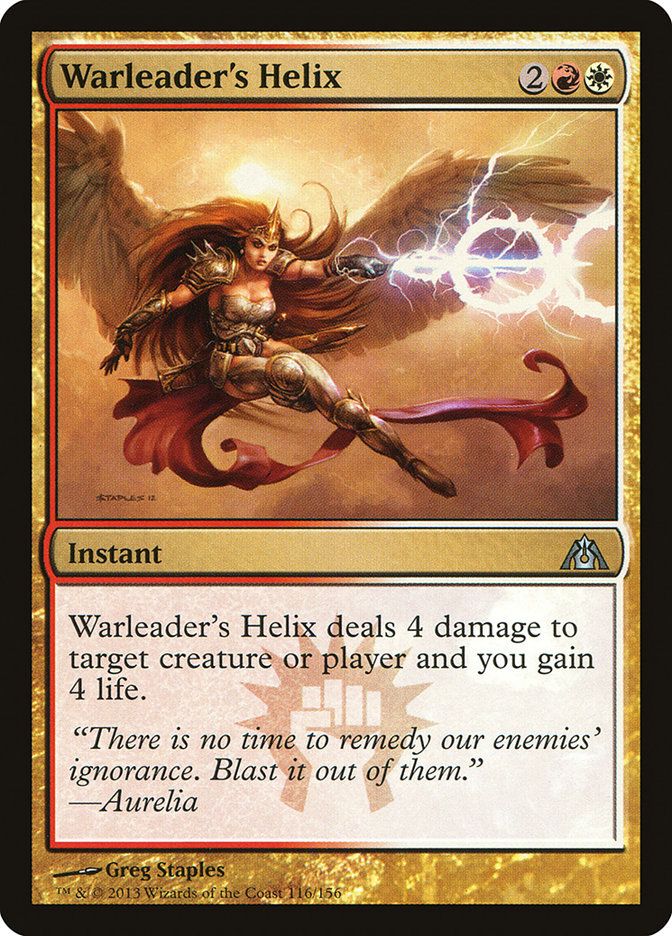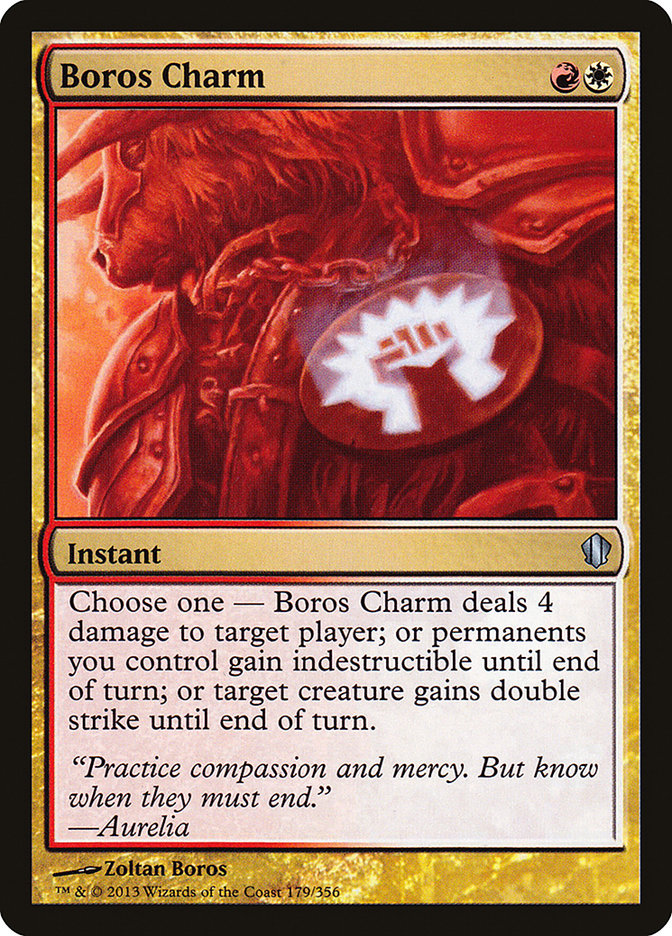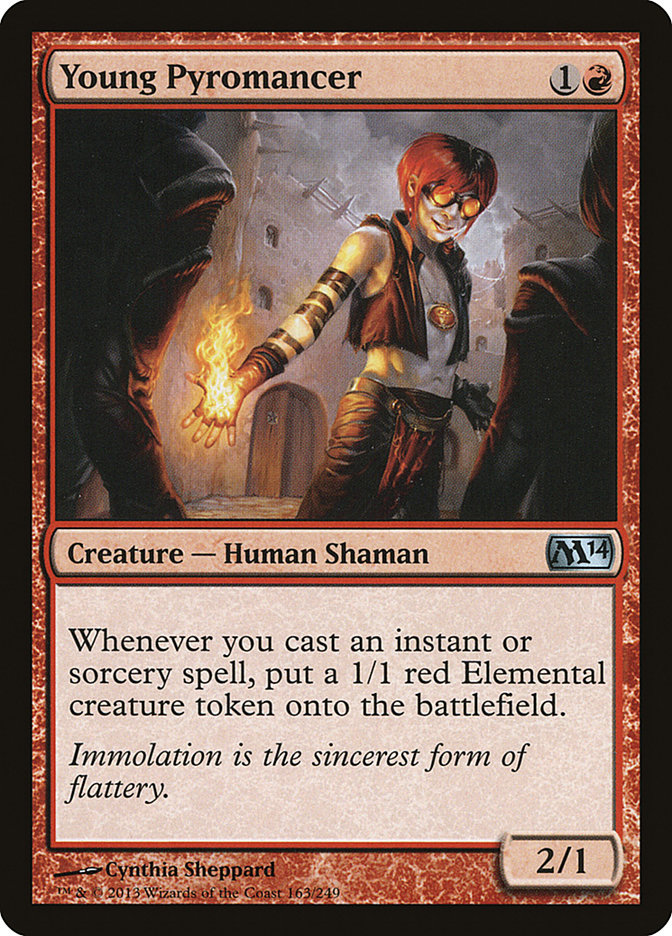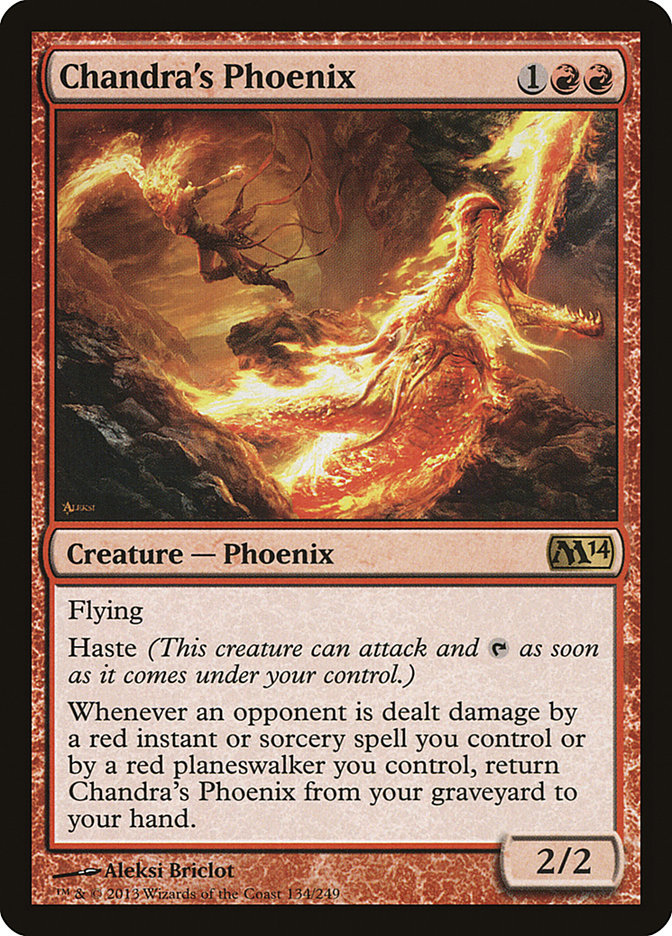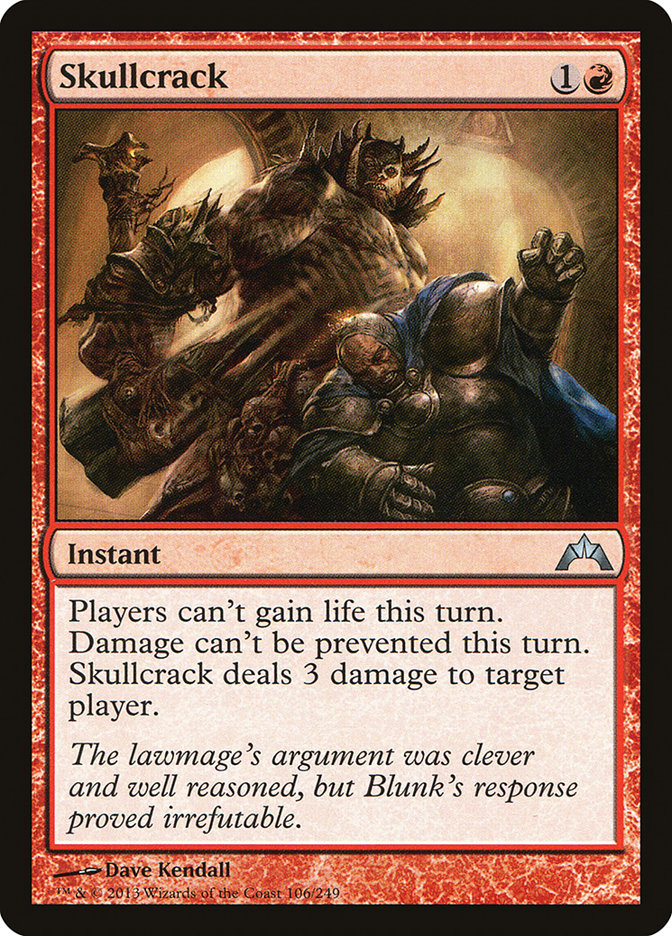There isn’t all that much time left to be playing Standard in the current format. The Khans of Tarkir prerelease will be happening right around the corner,
and once it is out, it is going to shove M14 and all of Return to Ravnica out the door. For people who like Burn, this is going to be a big change.
While it is possible that there might be something to be done about a dedicated burn deck in Khans Standard, it does seem unlikely. Jeskai Charm
does have a “deal four damage” component, and it could be something to pair with a Keranos deck, and Zurgo Helmsmasher does pack a powerful wallop.
However, it is going to be really hard for the deck to survive without these cards:
Just those two cards are a huge blow, utterly decimating the amount of damage you can do, and importantly, changing the character of most decks
that you can attempt to race against. Even then, there is still more that is lost:
For the burn list, Young Pyromancer and Chandra’s Phoenix have become the default creature spells, both because of how favorably they interact with the
rest of the deck, but also in that they can, for a very cheap investment, resiliently damage the opponent. Even cards we aren’t losing, like Stoke the
Flames, become all the more powerful in a Young Pyromancer deck. Skullcrack and Mutavault feel no less important. Of course, there are a handful of other
spells the deck is losing, but even the most-often used of these, Sacred Foundry, is actually fairly replaceable.
The truth is, the core of the Burn deck is being gutted. For me, this is a shame, because I’ve really grown to love this deck a great deal. It actually has
certainly really formed a lot of my experience in Standard the last year.
Burn was the deck that took me off of the Red Aggro splashing white that I’d been playing. This was the deck, primarily by Adam Jansen and Ronny Serio that
I’d taken to the Top 4 of an SCG Open and won a $5K event with. The PTQ season began, and I quickly realized I couldn’t handle a Burn deck built properly.
Later, when I placed in the Top 4 of GP Chicago with U/W Control with Planar Cleansing, a lot of that success was based on playing a deck that was
well-suited to fighting burn. Finally, when I gave Matt Sperling a ton of potential decks for Pro Tour M15, Burn, I told him, was my number two choice. He
started out with a version of Burn that I believe was more inspired by Saito than by my list, but he ended up at a list very close to what I’d sent him. In
the end, he was vanquished by U/W Control with Planar Cleansing.
This is a huge problem matchup.
Burn, you see, is a great deck, but the real problem it has when it comes to facing down that matchup is that it is dependent upon your opponent.
You can actually win the matchup pretty easily, but your opponent has to help, either with their play or with their lack of respect for what is possible in
the matchup. In the Swiss rounds, Sperling did end up beating Ivan Floch playing U/W Control (Floch made multiple errors), but in the Top 8, Sperling would
lose the rematch, though Floch gave him an opportunity to win game 1 when Floch unnecessarily took two damage from Hallowed Fountain.
Here is the list Matt Sperling played:
Creatures (9)
Lands (15)
Spells (36)

Like Sperling moved towards the version of the list I sent him, I’ve since moved closer to the version of the list that he played. There are still some
fundamental things I don’t like about what Sperling chose to play:
1) Too few Temples.
One of the ways that I do my mana is using “brute force” methods. This is just to say that I play the deck a lot and slowly count how many lands are the
appropriate number for each kind. It takes a while, and it takes a good sense of judgment. I’m very glad I was, for example, able to convince Matt to play
only three Sacred Foundry (a change he still thinks was correct). I was unable to convince him to play more than the four Temple of Triumphs, however. Not
only had other decks succeeded with more, but in my counting, the correct number of Temples was either six or seven. I was about 95% confident in six total
Temples, and about 45% confident in seven, at the time. These days, I’m closer to 99% confident in six Temples and 20% confident in seven.
This does increase the comes-into-play-tapped count, of course. But there are so few cards that you cast on one or three mana, you have a spot in your
curve where it is very natural to be able to drop a tapped land. Though there will be occasionally choices which make you forego a turn 1 Mutavault or
other mana hiccups, far more often are the uses of the land to smooth out your mana draws. In this deck, you don’t use Temples as a Preordain, saving it
until later. Instead, generally you use it as soon as is reasonable, trying to regulate your land/spell ratio to as good as possible. Selection isn’t
nearly as useful when so often so many of your cards are variants on the same thing.
2) Slightly overly anti-aggro stance
.
4 Shock, 4 Searing Blood. Starting your burn deck with this count is a declaration against small creatures. There is nothing wrong with this stance, per
se, but I do think that it is ever-so-slightly overkill. Shock, in a Young Pyromancer deck, is the slightly more powerful card per mana cost. Searing
Blood, on the other hand, is more powerful if we don’t put that in mind, but it is also more narrow. To me, given the rest of the composition of the deck,
you don’t really need to lean that far towards winning that matchup. If need be, you can have that last card in the sideboard.
3) An incorrect Elephant
.
The original Magic article on The Elephant Method was written by Seth Burn on the now defunct site Mindripper. (Does anyone still have a copy of this gem?
The site is gone, and I cannot find one.) Zvi Mowshowitz
gave an example of using the Elephant Method in deckbuilding just over a year ago. The basic idea is you need to imagine your deck as a
collection of different 60 card decks depending on your matchup, and that collection of decks can be represented by the 75 card deck and sideboard that you
end up with. If you imagine every matchup as having a corresponding 60 card deck, then you can see how your deck would look after board.
Unfortunately, as built, Sperling’s list had eight cards that it wanted to get rid of (4 Shock, 4 Searing Blood) and a collection of cards in the board
which underwhelmingly fit those eight spots (1 Banishing Light, 1 Eidolon of the Great Revel, 1 Skullcrack, 1 Wear // Tear, 2 Chandra Pyromaster, 2 Glare
of Heresy). It’s not that these cards don’t have a utility, it’s just that beyond the two copies of Glare of Heresy, which is a fairly ideal number, you
then have an abundance of specific removal, removal that won’t actually end up helping you kill the opponent. You are 58 cards plus 2-ish cards.
4) The wrong 36th/60th card for today
.
After the event, Sperling made note of the placeholder that Eidolon of the Great Revel made in the deck. It simply was one of those cards that had utility
but really faltered in a world of Courser of Kruphix decks. Not only did those decks very quickly not need to cast a card that would trigger Eidolon of the
Great Revel, but they also were generally equipped with good stopping power. There is nothing wrong with Eidolon of the Great Revel, but in this
post-Nissa, Worldwaker world, it just isn’t very well-suited. If your specific metagame is different, it can be a great card certainly.
5) The fundamental problem: U/W Control
.
How on earth do you actually make U/W Control a good matchup, as opposed to one that you have to let them let you win? Every single version of the
Burn deck I looked at in this quest was like Sperling’s: it was just a little shy.
On the ride back from Indianapolis after the WMCQ, while Brian Kowal purred and snored quietly in the seat next to me, Lukas Carlson and Aaron Lewis and I
discussed Burn. They both played the deck. Aaron played a more “traditional” build, and Lukas played the list I’d given him earlier that week, albeit
as something like 72 of the 75. He lost playing for Top 8 against a U/W Control deck, of course, and that was the end of his event.
During the drive, basically every single card in existence was discussed as a possible solution to the problem. Some, like Gideon, Champion of Justice,
attacked the problem from an entirely different angle. Others, like overloading on Toil // Trouble, simply went with the idea that it was a powerful card
in the matchup, and it could dodge Dispel. Still others sought to solve the problem of Sphinx’s Revelations by taking the issue head on with Possibility
Storm.
None felt satisfactory.
I ended up thinking back to an old list of mine from Pro Tour Hollywood. While there are some strange formatting issues in the article (for some reason, the
commas are gone), it really is an article about “How to Make a Good Red Deck in Standard”, at least circa 2008. Here was the list I played at PT
Hollywood to 60th place at 10-6:
Creatures (17)
Lands (7)
Spells (36)

I’m bringing out this blast from the past because it has one today-legal card in the 75 that my current version of Burn isn’t already playing. And it is a
doozy.
When I thought of this card, it was somewhat a revelation. If you’ve played the Burn on UW/x matchup, you know that the game ends up becoming a kind of
chess match where you patiently hold onto your Skullcrack to make sure that you get the maximum value from them, and after a certain point, you cautiously don’t cast certain spells so that you can at least leave up the potential illusion of Skullcrack. Between Skullcrack and Boros Charm, you
are oftentimes in a situation where it really feels as though you are engaged in a control war. And in many ways you are.
Wild Ricochet plays into this kind of gameplan nicely. At its worst case scenario, you can use Wild Ricochet to simply copy a burn spell, albeit for a lot
of mana. This can happen any time your opponent is tapped out. Even copying a Sphinx’s Revelation can be a powerful way to stay in the fight with a U/W
Control opponent; they may get to keep their copy, but filling up with a ton of cards will usually mean that the Burn player can keep up with the
lifegain (and I did once draw a Skullcrack off of my copy, “countering” their copy).
At its best, you can do truly absurd things. In one instance on Magic Online I had out Young Pyromancer with a ton of tokens and six mana facing down a
Jace and a Ram. My opponent cast a Sphinx’s Revelation with three mana open. I Skullcrack’d. They Dispel’d. I Stoked the Flames, trying to bait another
counter; they didn’t. I Stoked again and this time they Negated. I immediately Wild Ricochet’d their Negate, turning it against their Dispel and
their Revelation.
They did not win.
A card like Wild Ricochet becomes powerful in a format where you have reasonable things to copy. Way back in 2008, you were monkeying with Cryptic Command,
Profane Command, and Primal Command. At the same time though, other red decks casting Flame Javelin was a common occurrence. Here is how I put it then:
I’ve cast Wild Ricochet against a fair number of Stoke the Flames now. I’m still not sure which is more devastating: casting Wild Ricochet into Stoke the
Flames or into Warleader’s Helix. It feels pretty crazy either way.
This weekend is either the WMCQ in Philadelphia or the Open Series in Atlanta. I know that if you were to ask for my advice on what to play in either
event, it would be this:
Creatures (8)
Lands (17)
Spells (35)

There are a couple of potential variations to this list, all starting with the floating card, Toil // Trouble.
This is just a metagame call. I would recommend any card that costs three or less that fits the needs of your room. If you are in a room where Eidolon of
the Great Revel would be a good choice, by all means play it. Here are the cards I think are worth considering and why:
– Eidolon of the Great Revel – you expect to see very little Monsters/Planeswalkers
– Altac Bloodseeker – you expect to see a more varied metagame but with more creatures
– Toil // Trouble – you expect to see more UW/x and Black Devotion
– Annihilating Fire – you want to play it safe, and expect more G/W Aggro and Burn
– Boros Reckoner – you expect to see more Planeswalkers/Monsters and weenie decks
– Temple of Malice – you want to dodge the question entirely; incidentally, I’m not sure if I prefer this method to the 23 land, 2 Magma Jet method or not
Without knowing the current metagame in Philly or Atlanta, my choices in order would be: Toil // Trouble, Annihilating Fire, Altac Bloodseeker, Boros
Reckoner, Temple of Malice, Eidolon of the Great Revel. While I generally like Eidolon of the Great Revel (and I loved playing four of them main in Legacy
this last weekend), I don’t think now is the time for that card.
There are plenty of ways to build Burn. If you hope to light up Philly or Atlanta, this version would be my choice.
Good luck!


